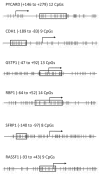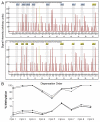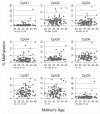Quantitative analysis of promoter methylation in exfoliated epithelial cells isolated from breast milk of healthy women
- PMID: 20716965
- PMCID: PMC3052848
- DOI: 10.4161/epi.5.7.12961
Quantitative analysis of promoter methylation in exfoliated epithelial cells isolated from breast milk of healthy women
Abstract
Promoter methylation analysis of genes frequently silenced in breast cancer is a promising indicator of breast cancer risk, as these methylation events are thought to occur long before presentation of disease. The numerous exfoliated epithelial cells present in breast milk may provide the breast epithelial DNA needed for detailed methylation analysis and assessment of breast cancer risk. Fresh breast milk samples and health, lifestyle, and reproductive history questionnaires were collected from 111 women. Pyrosequencing analysis was conducted on DNA isolated from the exfoliated epithelial cells immunomagnetically separated from the total cell population in the breast milk of 102 women. A total of 65 CpG sites were examined in six tumor suppressor genes: PYCARD (also known as ASC or TMS1), CDH1, GSTP1, RBP1 (also known as CRBP1), SFRP1, and RASSF1. A sufficient quantity of DNA was obtained for meaningful analysis of promoter methylation; women donated an average of 86 ml of milk with a mean yield of 32,700 epithelial cells per ml. Methylation scores were in general low as expected of benign tissue, but analysis of outlier methylation scores revealed a significant relationship between breast cancer risk, as indicated by previous biopsy, and methylation score for several CpG sites in CDH1, GSTP1, SFRP1, and RBP1. Methylation of RASSF1 was positively correlated with women's age irrespective of her reproductive history. Promoter methylation patterns in DNA from breast milk epithelial cells can likely be used to assess breast cancer risk. Additional studies of women at high breast cancer risk are warranted.
Figures






Similar articles
-
Increased promoter methylation in exfoliated breast epithelial cells in women with a previous breast biopsy.Epigenetics. 2011 Dec;6(12):1425-35. doi: 10.4161/epi.6.12.18280. Epigenetics. 2011. PMID: 22139572
-
Promoter methylation in epithelial-enriched and epithelial-depleted cell populations isolated from breast milk.J Hum Lact. 2014 Nov;30(4):450-7. doi: 10.1177/0890334414548224. Epub 2014 Aug 27. J Hum Lact. 2014. PMID: 25164041
-
Promoter hypermethylation of the tumor-suppressor genes RASSF1A, GSTP1 and CDH1 in endometrial cancer.Oncol Rep. 2013 Dec;30(6):2878-86. doi: 10.3892/or.2013.2752. Epub 2013 Sep 25. Oncol Rep. 2013. PMID: 24068440
-
Gene methylation in gastric cancer.Clin Chim Acta. 2013 Sep 23;424:53-65. doi: 10.1016/j.cca.2013.05.002. Epub 2013 May 10. Clin Chim Acta. 2013. PMID: 23669186 Review.
-
Epigenetic biomarkers of promoter DNA methylation in the new era of cancer treatment.Cancer Sci. 2018 Dec;109(12):3695-3706. doi: 10.1111/cas.13812. Epub 2018 Oct 26. Cancer Sci. 2018. PMID: 30264476 Free PMC article. Review.
Cited by
-
The Susan G. Komen for the Cure Tissue Bank at the IU Simon Cancer Center: a unique resource for defining the "molecular histology" of the breast.Cancer Prev Res (Phila). 2012 Apr;5(4):528-35. doi: 10.1158/1940-6207.CAPR-11-0234. Epub 2012 Feb 17. Cancer Prev Res (Phila). 2012. PMID: 22345117 Free PMC article.
-
Early-Stage Breast Cancer Detection in Breast Milk.Cancer Discov. 2023 Oct 5;13(10):2180-2191. doi: 10.1158/2159-8290.CD-22-1340. Cancer Discov. 2023. PMID: 37704212 Free PMC article.
-
Long intergenic non-coding RNA APOC1P1-3 inhibits apoptosis by decreasing α-tubulin acetylation in breast cancer.Cell Death Dis. 2016 May 26;7(5):e2236. doi: 10.1038/cddis.2016.142. Cell Death Dis. 2016. PMID: 27228351 Free PMC article.
-
New Moms Wellness Study: the randomized controlled trial study protocol for an intervention study to increase fruit and vegetable intake and lower breast cancer risk through weekly counseling and supplemental fruit and vegetable box delivery in breastfeeding women.BMC Womens Health. 2022 Sep 24;22(1):389. doi: 10.1186/s12905-022-01967-9. BMC Womens Health. 2022. PMID: 36153518 Free PMC article.
-
Postpartum remodeling, lactation, and breast cancer risk: summary of a National Cancer Institute-sponsored workshop.J Natl Cancer Inst. 2013 Feb 6;105(3):166-74. doi: 10.1093/jnci/djs505. Epub 2012 Dec 21. J Natl Cancer Inst. 2013. PMID: 23264680 Free PMC article. Review.
References
-
- SEER cancer statistics review 1975–2006. 2008
-
- Esserman LJ, Shieh Y, Park JW, Ozanne EM. A role for biomarkers in the screening and diagnosis of breast cancer in younger women. Expert Rev Mol Diagn. 2007;7:533–544. - PubMed
-
- Buehring GC, Letscher A, McGirr KM, Khandar S, Che LH, Hackett AJ. Presence of epithelial cells in nipple aspirate fluid is associated with subsequent breast cancer: A 25-year prospective study. Breast Cancer Res Treat. 2006;98:63–70. - PubMed
-
- Fabian CJ, Kimler BF, Mayo MS, Khan SA. Breast-tissue sampling for risk assessment and prevention. Endocr Relat Cancer. 2005;12:185–213. - PubMed
-
- Arun B. Ductal lavage and risk assessment of breast cancer. Oncologist. 2004;9:599–605. - PubMed
Publication types
MeSH terms
Substances
LinkOut - more resources
Full Text Sources
Other Literature Sources
Research Materials
Miscellaneous
